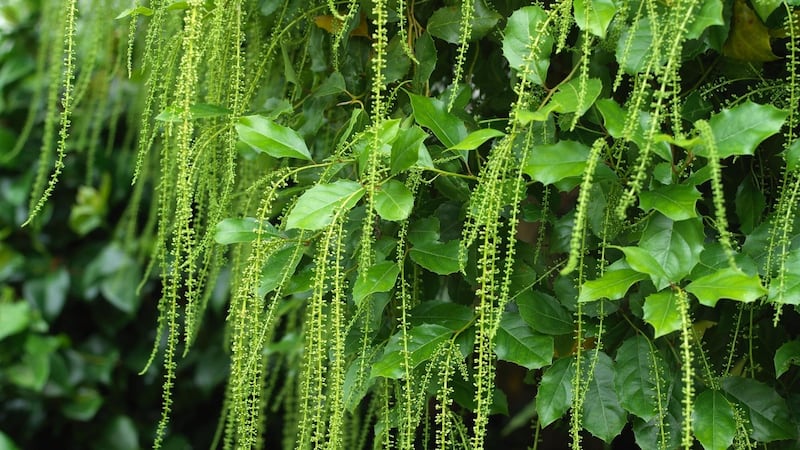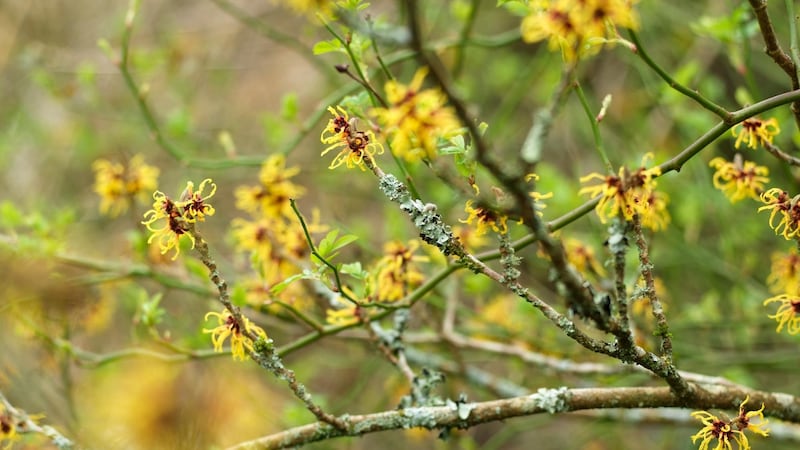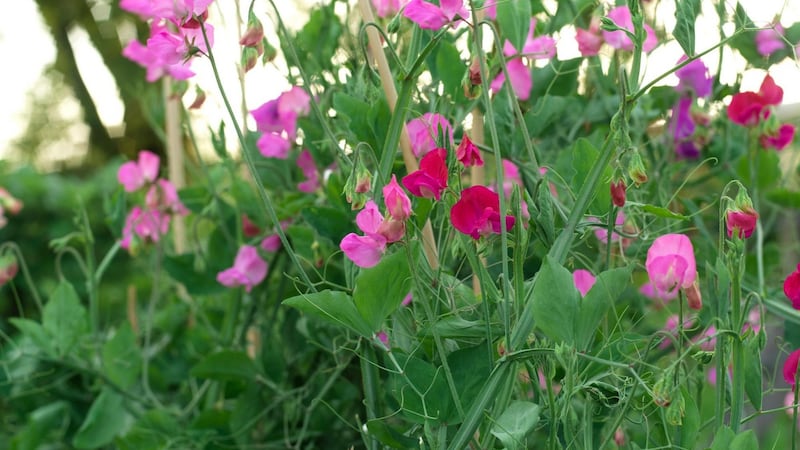The average Irish garden is getting smaller. Not literally shrinking, I should add (because that sort of thing only happens in Tim Burton movies), but gradually decreasing in size. Where truly tiny Irish gardens were once something of a rarity, they are now increasingly the norm.
Much has been written about the challenges presented by these sort of pocket-sized spaces. The problem of shade caused by tall buildings standing cheek-by-jowl, for example. Or the difficulty of creating year-round-interest. Or the struggle to provide privacy.
The answer is to garden upwards rather than outwards by clothing those walls and fences with a delightful array of climbing plants
But rather than banging on about the drawbacks, I’d like to concentrate on one of their great but unsung charms – the amount of vertical growing space they typically provide in the shape of tall house walls and high boundary fences.

Just take a moment to imagine all those available vertical spaces as if they were horizontal, and suddenly these tiny gardens don’t seem so tiny. In other words, the answer is to garden upwards rather than outwards by clothing those walls and fences with a delightful array of climbing plants.
Not only will these provide plenty of seasonal interest in decorative foliage, flowers and ornamental seedheads, but they will also act as a valuable haven for garden wildlife.
Which kinds?
If it's evergreen interest that you covet then the elegant star jasmine, trachelsopermum jasminoides, is a fine choice for a small but sheltered city plot. The considerable charms of its year-round glossy green foliage and neat growing habit aside, its clusters of dainty deeply-scented white flowers are produced throughout the summer months. Although best in full sun, it will tolerate light shade.

Speaking of the latter, one of the best shade-tolerant evergreen climbers for clothing a wall or garden fence is the ornamental ivy known as Hedera “Gloire de Marengo”, a vigorous self-clinging plant whose large cream-variegated leaves will light up a dark space.
Self-clinging
Others include the hardy self-clinging, white-flowering Pileostegia viburnoides, the summer-flowering Hydrangea seemannii (this needs a sheltered spot) and the compact spring-blooming Clematis "Pixie".
Evergreens aside, ring in the different seasons with a range of deciduous flowering climbers. Again, the Clematis genus reigns supreme in this regard, with a vast range of species/ varieties capable of providing interest at almost any time of the year.
Hardy, resilient and happy in either sun or partial shade, it looks lovely growing up the branches of a wall-trained shrub such as the evergreen <em>Azara microphylla</em>
For spring blooms choose from the many fine varieties of Clematis alpina, a species that will happily tolerate a shady wall or fence, producing a vertical carpet of dainty bell-shaped blooms in April/May.
For summer beauty you can't beat a variety like Clematis "Alba Luxurians", a prolific flowerer whose large white, green-tipped flowers appear from July-September and will do a brilliant job (as will most pale flowers or foliage) of lighting up a shady spot. Hardy, resilient and happy in either sun or partial shade, it looks lovely growing up the branches of a wall-trained shrub such as the evergreen Azara microphylla. The latter will also provide you with seasonal interest in the shape of its small but deeply-scented yellow flowers which appear in late winter.

For late summer/early autumn pick a variety of the ultra-hardy drought-tolerant Clematis viticella, which will happily grow in full sun or partial shade. Classics include C. "Etoile Violette" (violet flowers from July-early October), C. "Julia Correvon" (dark-red flowers with a yellow eye from July to November) and C. "Purpurea Plena Elegans" (small plum-coloured double flowers), while one of the last to flower is C. "Polish Spirit". Where space is especially tight any of these clematis varieties will grow quite happily in a large pot or tub as long as you keep them well fed and watered.
Rambling roses
Climbing and rambling roses will also produce plenty of wonderfully scented colourful, beautiful summer blooms as long as you can provide them with a humus-rich moist but well-drained soil.
Concentrate on vigorous disease-resistant repeat-flowering relatively compact varieties such as the rambling pale-pink “Phyllis Bide”, the climbing form of the pale-pink “Cecile Brunner” or the shade-tolerant, deeply scented mid-pink “James Galway”. For an extra wallop of summer colour and scent add a few fast-growing sweet pea plants.
The soil of the average tiny city garden is typically dry and very impoverished
Many shrubs are also ideal for training against a wall or garden fence. The aforementioned Azara aside, examples include the lovely Itea ilicifolia whose highly ornamental vanilla-scented, dangling lime-green catkins appear from July-September; the sun-loving silver-leaved pineapple broom (Cytisus battandieri) whose large egg-yolk yellow flowers appear in early summer; the shade-tolerant, evergreen silk-tassle bush Garrya "Glasnevin Wine" whose burgundy-red flower tassels appear from late winter-spring; and even – if given an annual spring pruning by cutting the previous year's growth back to two buds – the lovely shade-tolerant winter-flowering witch hazel (Hamamelis).
Whichever plants you choose do your very best to create the best growing conditions. The soil of the average tiny city garden is typically dry and very impoverished, so enrich it with plenty of manure/homemade garden compost, a sprinkle of dried seaweed powder and a handful of pelleted organic fertiliser before planting.
Top dressing
Aim to add further generous top dressings around the roots of plants each spring. Make sure to plant at least 30cm away from the base of any wall/fence to give vulnerable root systems the very best chance of getting established (walls and fence posts wick up water from the soil) and provide support for non-clinging plants with horizontal lengths of sturdy wires fixed to screws/nails.
The reward for all that effort will be a pint-sized garden that punches way above its weight
Don’t be afraid to cut back plants that have exceeded their allotted space, while if you’re growing climbers in containers take extra care when it comes to maintaining a regular watering/feeding routine.
The reward for all that effort will be a pint-sized garden that punches way above its weight.
THIS WEEK IN THE GARDEN
Aphids are a common pest of many plants at this time of year, and can often be seen on shoot tips, flower buds and young leaves. However, the good news is that they have plenty of natural predators – ladybirds, parasitic wasps, the larvae of lacewings and hoverflies – who will naturally control bad infestations in the garden. So try to avoid the use of environmentally-damaging insecticidal sprays as these will only have the undesired effect of killing these natural predators. Let nature do its work.
If you're growing your sweet pea plants in a tub or container it's also vital that the roots are never allowed to dry out
In the kitchen garden/allotment there’s still time to sow seed of lettuce, radishes, turnips, Florence fennel and kohl-abi. Early potatoes may also be ready to harvest: to check use a trowel or garden fork to gently excavate around the roots of a plant, taking care not to damage the foliage. Remember that early varieties of potatoes should be eaten as soon as possible after being lifted so only harvest as much as you need.
Sweet pea plants should now be producing plenty of deliciously-scented blooms. To keep flower production going for as long as possible it’s important to pick these every day as otherwise much of the plants’ energies will quickly go into seed production. If you’re growing your sweet pea plants in a tub or container it’s also vital that the roots are never allowed to dry out, while a weekly potash-rich liquid feed is also very beneficial.
DATES FOR YOUR DIARY
Saturday, July 9th (10am-5pm), Blarney Castle, Co Cork: Blarney in Bloom, a summer garden fair in aid of Irish Guide Dogs for the Blind with specialist plant sales, traditional arts and crafts, farmers' market and talks by garden experts. Admission €8 (adults) includes access to the gardens and free admission for children under 12. See blarneycastle.ie
From Wednesday, July 5th, to Sunday, August 27th: Hidden Treasures of the Museum Collection, Visitors' Centre, National Botanic Gardens, Glasnevin, Dublin, an exhibition of plant products and plant-derived artefacts from a collection created by David Moore, former curator of the National Botanic Gardens, from 1838-1879. See botanicgardens.ie

















